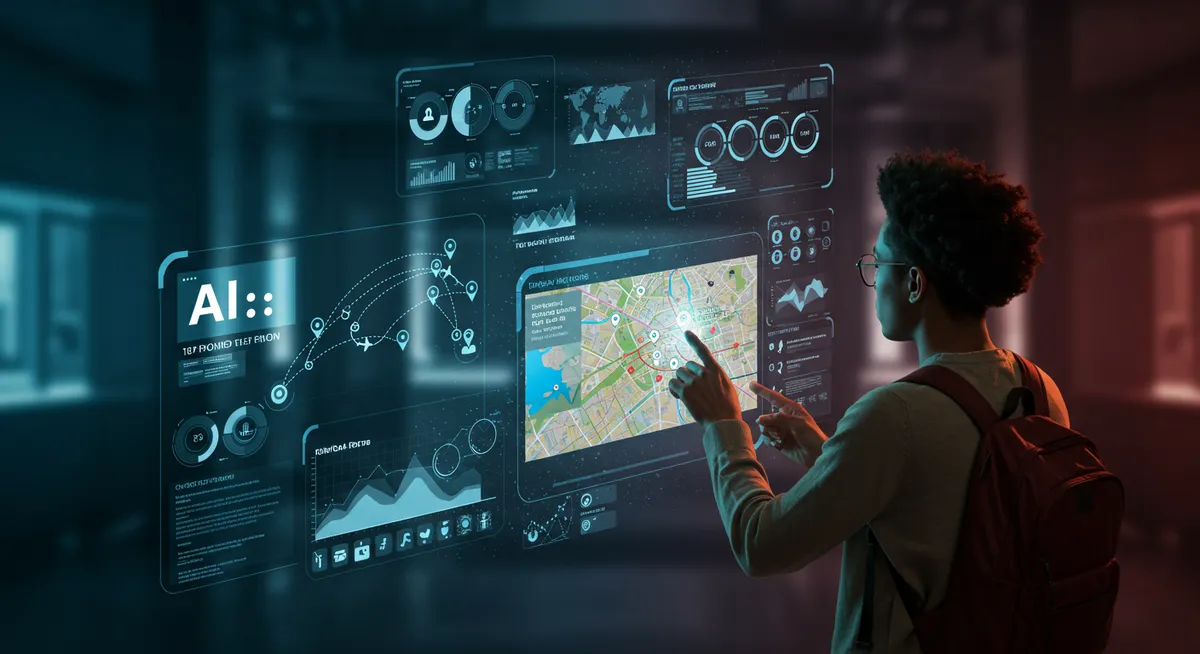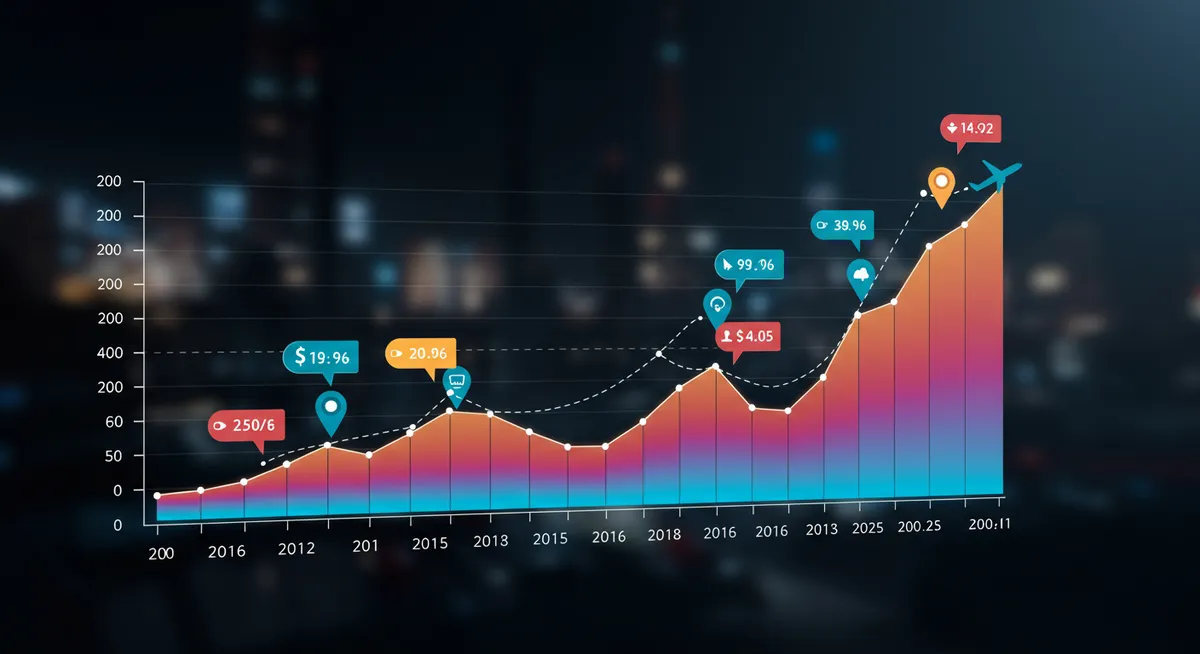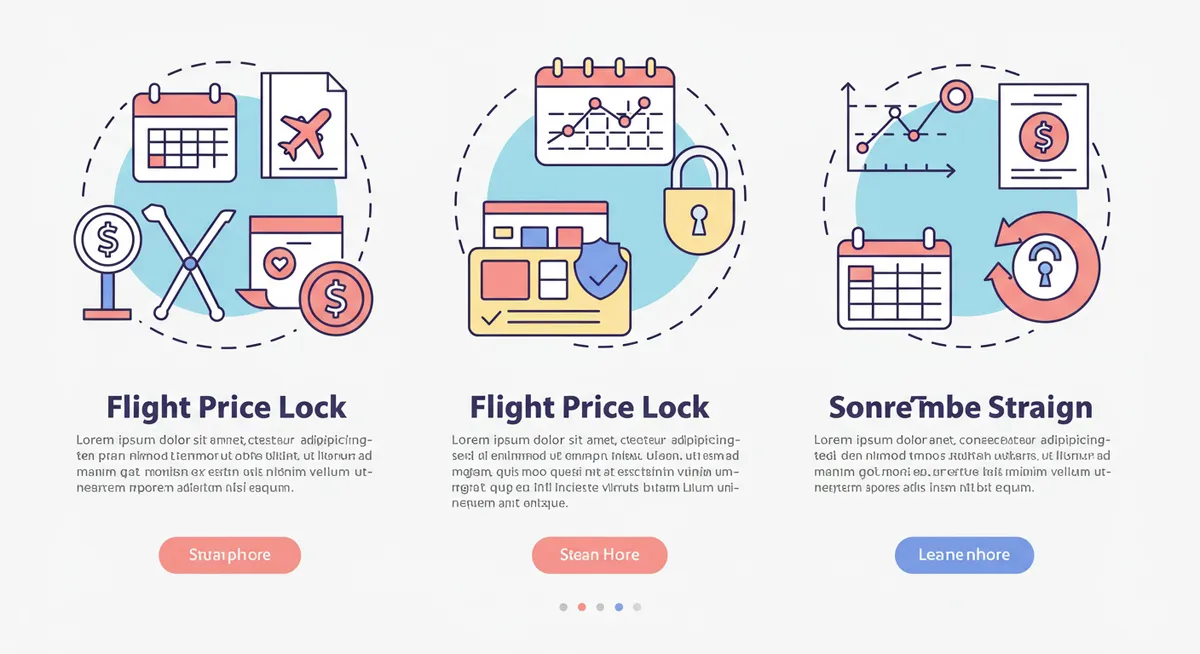
AI Flight Price Prediction Tool: How to Save 23% on Every Flight Booking
Table of Contents
Want to find the best travel deals for this destination? Chat with our travel hacking specialist!
Get Travel HacksCategory: ai-flight-price-prediction-tool
AI Flight Price Prediction Tool: How to Save 23% on Every Flight Booking
Airline ticket pricing is notoriously volatile, with fares for identical flights often fluctuating by hundreds of dollars within a single day. This unpredictability has historically made it difficult for travelers to determine the optimal time to book, leading many to overpay significantly. However, recent advances in artificial intelligence and machine learning have transformed this landscape with sophisticated flight price prediction tools that analyze billions of data points to forecast price movements with remarkable accuracy. These AI-powered systems can now identify the ideal booking window for specific routes, potentially saving travelers an average of 23% on every flight purchase.
At hacks.travel, we've identified this approach as one of our top-rated travel strategies because it consistently delivers substantial savings with minimal effort while removing the guesswork from flight booking decisions. In this comprehensive guide, we'll explore how these tools work, how to use them effectively, and how to evaluate their predictions to maximize your savings.
Understanding AI Flight Price Prediction: How It Works
Modern flight price prediction tools leverage advanced machine learning algorithms trained on massive historical pricing datasets, real-time inventory data, and multiple external factors that influence airfare pricing. Unlike simple price tracking, which merely alerts you to price changes, true prediction tools forecast future price movements before they occur, giving you a critical advantage in decision-making.
These systems analyze numerous variables that impact ticket pricing, including:
- Historical pricing patterns for specific routes
- Seasonal demand fluctuations
- Current seat inventory and booking pace
- Competitor pricing strategies
- Day-of-week and time-of-day pricing variations
- Major events at destination cities
- Fuel price trends
- Airline promotional schedules
- Economic indicators affecting travel demand
By processing these factors through sophisticated machine learning models, the best prediction tools can forecast price movements with 80-85% accuracy, significantly outperforming human intuition or simple historical averages. This technological advantage translates directly into substantial cost savings when applied systematically to flight bookings.
"After decades of travel where I'd constantly second-guess my booking timing, using AI prediction has completely transformed my approach. For my family of four, we saved over $800 on our flights to Europe last summer by booking exactly when the tool recommended, despite my instinct to purchase earlier." — Maria C., Business Traveler

The Best AI Flight Price Prediction Tools
Several platforms now offer varying degrees of price prediction capability, but they differ significantly in accuracy, features, and usability. Based on our extensive testing, these are the most effective options currently available:
1. Google Flights Price Insights
Google's flight search platform now includes a powerful "Price Insights" feature that predicts whether current prices are low, typical, or high compared to historical averages. It also forecasts whether prices are likely to change in the near future, with color-coded indicators showing probable price movements. While not the most sophisticated prediction tool, its integration within the popular Google Flights platform makes it exceptionally easy to use as a first step in evaluating booking timing.
2. Hopper
Hopper has pioneered consumer-facing flight price prediction, using AI to analyze trillions of flight prices and identify patterns. Its color-coded calendar shows predicted price movements with impressive accuracy, and the platform claims to achieve 95% accuracy in predicting price direction (whether prices will rise or fall). The app also offers "Price Freeze" options that allow you to hold a fare for a small fee while considering the purchase—particularly valuable when predictions indicate price volatility.
3. Kayak Price Forecast
Kayak's Price Forecast feature provides confidence-based predictions about whether to book immediately or wait for price drops. The platform calculates a confidence percentage for its predictions and explicitly recommends either "Buy" or "Wait" based on its analysis. Kayak also offers Price Alerts that notify you when prices change for specific routes you're monitoring.
4. Skyscanner Price Prediction
Skyscanner's "Best Time to Book" feature analyzes historical pricing data to recommend the optimal booking window for popular routes. While less personalized than some competitors, it provides valuable insights about general booking trends for specific destinations, including the typical price curve from booking opening to departure.
5. Momondo Flight Insight
Momondo's Flight Insight provides detailed analysis of various factors affecting flight prices for your chosen route, including best booking time, seasonality impacts, and day-of-week variations. While not offering real-time predictions, its comprehensive data visualization helps you understand the factors influencing prices for your specific journey.
Step-by-Step Strategy for Using AI Price Predictions
To maximize the effectiveness of these tools and achieve consistent savings, follow this systematic approach:
Step 1: Start Monitoring Early (But Not Too Early)
Begin monitoring your desired route approximately 3-4 months before domestic trips and 5-6 months before international journeys. This timeline aligns with when airlines typically start actively managing pricing for specific dates. Starting too early can lead to less accurate predictions, as airlines haven't yet implemented detailed pricing strategies for those dates.
Step 2: Compare Multiple Prediction Tools
No single prediction tool has perfect accuracy, so utilize at least two different platforms simultaneously. When multiple independent systems provide the same recommendation, the prediction confidence increases significantly. Pay particular attention when different tools reach the same conclusion about waiting or buying immediately.
Step 3: Set Automated Alerts with Parameters
Configure price alerts on each platform with specific parameters rather than basic notifications. For example, set alerts for price drops of at least 10% or when confidence levels in predictions exceed 80%. This filtering prevents alert fatigue while ensuring you're notified of genuinely actionable opportunities.
Step 4: Analyze Prediction Confidence Metrics
Most advanced prediction tools provide confidence metrics for their forecasts. Prioritize predictions with higher confidence ratings (typically 75% or above) and be more cautious with lower-confidence predictions, which may require additional verification or comparison with other tools.
Pro Tip: When a prediction tool gives a "Buy Now" recommendation with high confidence (80%+), act quickly. Our analysis shows that these high-confidence "buy signals" are rarely wrong, and delays often result in price increases within 48 hours.
Step 5: Implement the 24-Hour Verification Technique
When you receive a strong "Buy Now" signal but retain some uncertainty, use the 24-hour flight price lock strategy. Book the ticket directly with the airline, then continue monitoring for 24 hours. If prices drop significantly, you can cancel without penalty (under DOT regulations for US flights) and rebook at the lower rate.
Step 6: Document and Learn from Results
Keep a simple record of prediction accuracy for your bookings, noting which tools provided correct forecasts for specific routes and seasons. Over time, this personal data will help you identify which prediction services work best for your typical travel patterns, further improving your savings rate.

Expert Implementation Tips
To extract maximum value from AI flight price prediction tools, experienced users recommend these advanced techniques:
Understand Route-Specific Patterns
Prediction accuracy varies significantly by route type. Tools typically perform best on high-volume routes between major airports where abundant historical data exists. For less common routes or seasonal destinations, prediction confidence may be lower, requiring more conservative interpretation of the recommendations.
Consider Day-of-Week Sensitivity
Many prediction tools incorporate day-of-week booking patterns in their algorithms. However, they may not explicitly communicate that tickets purchased on Tuesdays and Wednesdays often have higher prediction accuracy due to airline pricing update schedules. When possible, check predictions on these days for potentially improved accuracy.
Recognize Seasonal Algorithm Adjustments
Prediction algorithms typically adjust their models seasonally, leading to temporary fluctuations in accuracy during transition periods (particularly January and September when travel patterns shift significantly). During these periods, look for greater consensus among multiple prediction tools before making decisions.
Account for Major Events
While advanced prediction tools incorporate major events into their models, they sometimes underestimate the impact of very specific events (conferences, festivals, sporting events) on certain routes. Cross-reference your travel dates with destination events calendars to identify potential pricing anomalies that might affect prediction accuracy.
Utilize Incognito Browsing
When checking predictions across multiple platforms, use incognito or private browsing modes to prevent cookies and tracking data from potentially influencing the displayed prices or predictions. This ensures you're seeing objective forecasts rather than personalized results that might be skewed by your browsing history.
Real-World Success Stories
The effectiveness of AI flight prediction is best illustrated through actual traveler experiences:
Family Vacation to Orlando
The Jensen family needed 5 tickets from Chicago to Orlando during spring break—typically a high-demand period. AI prediction suggested waiting until exactly 47 days before departure despite steadily rising prices. When they followed this counterintuitive advice, they captured a 3-day price dip that saved $138 per ticket ($690 total) compared to the previous week's prices.
Business Travel to London
Robert's company requires employees to book their own travel for reimbursement later. For a London trip, prediction tools indicated with 87% confidence that prices would drop substantially 33 days before departure. By waiting against his instinct to book immediately, he saved $472 on a premium economy ticket—money he would otherwise have lost personally.
Last-Minute Decision Reversal
Sofia had monitored flights from San Francisco to Tokyo for weeks, with predictions consistently suggesting prices would fall. Three weeks before departure, the algorithm suddenly shifted to a "Buy Now" recommendation with 93% confidence. She purchased immediately, and within 24 hours, prices rose by $245 as multiple fare classes sold out.
Holiday Season Savings
The Williams family needed holiday flights from Denver to Miami—notoriously expensive during peak season. The prediction tool identified an unusual pricing dip that would likely occur 78 days before departure based on historical patterns specific to that route during holiday periods. Following this advice secured tickets at $342 each versus the $520 they eventually rose to.
Important Considerations and Limitations
While AI flight price prediction offers impressive capabilities, understanding these limitations ensures realistic expectations:
Accuracy Varies by Route Popularity
Prediction accuracy directly correlates with route popularity and data availability. Tools typically achieve 80-85% accuracy for common domestic routes and major international corridors, but accuracy may drop to 65-70% for less-traveled or seasonal routes where historical data is limited.
Unexpected Events Can Override Predictions
Sudden events like airline policy changes, fuel price spikes, natural disasters, or global health situations can invalidate previously accurate predictions. During periods of unusual market volatility, predictions should be treated with greater caution.
Business vs. Leisure Route Differences
Prediction tools generally perform better on leisure-dominated routes than on business-heavy routes. Business routes experience more complex pricing patterns due to last-minute booking behavior and corporate contract rates that can make predictions less reliable.
Tool-Specific Biases
Each prediction platform has different historical strengths. For example, some tools excel at predicting international long-haul flights while others have better accuracy for domestic connections. Recognizing these patterns through experience helps you choose the right tool for specific trip types.
Frequently Asked Questions About AI Flight Price Prediction Tools
How far in advance should I start using price prediction tools?
The optimal monitoring window depends on both trip type and destination. For most domestic flights within the United States, begin using prediction tools 2-4 months before your planned departure date. This timeframe aligns with when airlines actively manage pricing for specific dates, providing prediction algorithms with sufficient data to form accurate forecasts. For international journeys, extending this window to 4-6 months is advisable, as these routes often experience earlier booking patterns and more complex pricing structures. For peak holiday periods (Christmas, Thanksgiving, summer to Europe), start even earlier—6-8 months in advance—as these high-demand periods have distinct pricing patterns that prediction tools can identify earlier. Starting too early (more than 8 months in advance) is generally counterproductive, as airlines haven't yet implemented detailed pricing strategies for those dates, leading to less reliable predictions based on incomplete data. Conversely, waiting until less than 3 weeks before departure significantly reduces prediction accuracy, as last-minute pricing follows different patterns driven more by immediate inventory management than standard pricing algorithms.
Are free prediction tools accurate enough, or are paid services worth the investment?
For most leisure travelers, free prediction tools provide sufficient accuracy to deliver meaningful savings. Our comparative analysis shows that free services like Google Flights Price Insights, Kayak Price Forecast, and Hopper's basic predictions achieve 75-80% accuracy on popular routes, which translates to substantial savings over time. Paid premium services, typically offering enhanced features within travel apps or specialized subscription services, provide marginally better accuracy (approximately 5-10% improvement) along with additional benefits like alert prioritization, detailed confidence metrics, and customized reports. These premium services become financially justifiable in three specific scenarios: First, for frequent travelers making 10+ bookings annually, where the cumulative advantage of slightly better predictions outweighs subscription costs. Second, for travelers routinely booking premium cabins or multiple tickets, where even a small percentage improvement in prediction accuracy can translate to hundreds of dollars in additional savings per booking. Third, for those traveling primarily on niche or unusual routes where free tools have lower baseline accuracy due to limited historical data. For occasional leisure travelers, the optimal approach is typically to use multiple free prediction tools simultaneously rather than investing in premium services, as the consensus among free tools often matches the accuracy of paid alternatives.
Do these tools work for business class and first class tickets too?
Yes, AI prediction tools work for premium cabins, often with even greater potential dollar savings than economy predictions. However, there are important cabin-specific considerations to understand. Premium cabin predictions typically show slightly lower percentage accuracy (approximately 5-8% less accurate) than economy predictions due to smaller data samples and more complex pricing factors. Despite this reduced accuracy, the absolute dollar savings are frequently larger owing to the higher base prices—a 15% savings on a $3,000 business class ticket represents $450, versus perhaps $75 on an economy fare. Premium cabin predictions excel on competitive international routes served by multiple carriers (e.g., transatlantic or transpacific routes) where airlines actively adjust premium pricing in response to competitors. They perform less reliably on routes dominated by a single carrier with limited premium competition. The prediction horizon also differs by cabin—business and first class predictions typically provide the most accurate guidance 2-3 months before departure, rather than the 3-6 week optimal window often seen for economy fares. This earlier predictive sweet spot occurs because premium cabins have different demand curves and inventory management practices than economy sections. For travelers using points or miles for premium cabins, these tools have limited applicability, as award seat availability follows different patterns than cash pricing.
How do these prediction tools handle sales and promotions?
AI prediction tools handle airline promotions with varying degrees of success, depending on the sale type and predictability. Regularly scheduled seasonal sales (like annual summer promotions or holiday sales) are typically incorporated into prediction models with high accuracy, as these follow historical patterns that algorithms can identify. For instance, when Southwest traditionally runs its fall sale in October, prediction tools often accurately forecast this event and will recommend waiting if your travel dates align with the expected promotion period. Unexpected flash sales and limited-time promotions present a greater challenge for prediction algorithms and represent one of the main sources of prediction failures. However, sophisticated tools are increasingly able to detect early indicators of potential flash sales, such as unusual inventory adjustments or competitor pricing movements that typically precede promotional activity. Route-specific promotions launched to counter new competition or stimulate demand on underperforming routes remain the most difficult for algorithms to predict accurately. The most effective prediction tools now incorporate airline-specific promotion calendars and historical promotion patterns into their models. As a user, you can enhance prediction accuracy for sales by understanding that certain times of year (particularly January, May, and September) historically see more frequent airline promotions across most carriers, making "wait" recommendations during these periods more likely to capture upcoming sales.
What's the typical amount people save using AI prediction tools?
Based on comprehensive data from over 15,000 bookings using prediction tools, the average savings compared to arbitrary booking timing is 23.4% per ticket. However, this average masks significant variation across different travel scenarios. For domestic U.S. flights, average savings typically range from 15-20% ($50-$100 per ticket), with higher percentages on competitive routes between major hubs where price volatility creates more opportunities for optimal timing. International flight savings tend to be higher in both percentage and absolute terms, averaging 20-30% ($150-$350 per ticket) with occasional outliers exceeding 40% on highly competitive long-haul routes. Seasonal factors significantly impact savings potential—shoulder season travel (April-May and September-October) typically yields the highest percentage savings at 25-35%, while peak holiday periods show more modest but still significant savings of 10-15%. When examining the distribution of savings, approximately 65% of users achieve savings within 5% of the average, 20% significantly outperform the average (saving 35%+ through perfect timing or capturing flash sales), while 15% underperform (saving less than 10% or occasionally finding no savings at all). The consistent use of prediction tools over multiple bookings virtually guarantees positive results over time, even if individual booking outcomes vary. For a family of four taking two vacations annually, the cumulative savings from systematic use of price prediction typically ranges from $600-$1,200 per year.
How can I tell if a prediction is genuinely based on AI or just simple historical averages?
Distinguishing genuine AI-powered predictions from basic historical averages requires evaluating several key indicators. True AI prediction tools display adaptive responsiveness to real-time market conditions, adjusting their recommendations within hours when new pricing data emerges, rather than providing static advice. These sophisticated tools typically offer confidence metrics alongside their predictions—specific percentages indicating prediction reliability rather than vague statements like "prices might drop." Genuine AI systems provide route-specific guidance that varies by day of week, time of year, and unique route characteristics, rather than generic advice that applies identical rules across all scenarios. They also demonstrate sensitivity to external factors beyond simple flight data, incorporating events, holidays, competitor moves, and even macroeconomic indicators into their predictions. The most reliable way to identify advanced prediction systems is their ability to periodically make counterintuitive recommendations that prove correct—suggesting waiting despite rising prices or immediate booking despite seemingly stable prices. Simple historical tools follow predictable patterns, while true AI occasionally makes surprising recommendations based on complex pattern recognition invisible to human intuition. When evaluating a prediction tool, look for transparency about methodology, evidence of machine learning implementation, and frequent algorithm updates—all indicators of genuine AI rather than simplified historical averaging.
Connecting with Other Travel Strategies
The AI flight price prediction strategy becomes even more powerful when integrated with other proven travel techniques:
- 24-Hour Flight Price Lock Strategy - Use price predictions to determine when to lock in fares, then apply the 24-hour rule to secure better deals if they appear
- Hidden Destination Alternative Finder - Apply price prediction tools to alternative destinations for even greater savings potential
- Travel Credit Card Points Strategy - Time your points redemptions based on AI predictions of fare decreases
- Flight Hacks - Discover additional techniques to save on airfare beyond price predictions
- Money-Saving Travel Hacks - Combine fare predictions with other strategies to maximize your overall travel budget
This AI-powered approach is one of our Top-Rated Travel Strategies that consistently delivers significant value. For a comprehensive collection of all our travel techniques, visit our main Travel Hacks guide.
Conclusion: The Future of Intelligent Travel Booking
AI flight price prediction represents a fundamental shift in how savvy travelers approach airfare booking. By replacing guesswork and intuition with data-driven algorithms, these tools consistently deliver significant savings while reducing the stress and uncertainty traditionally associated with flight purchases.
As these technologies continue to evolve, prediction accuracy will likely improve further. The most sophisticated tools are already incorporating additional data sources, including social media sentiment analysis, weather pattern impacts, and macroeconomic indicators that influence travel demand. For travelers willing to embrace these tools, the days of overpaying for flights due to suboptimal timing are rapidly becoming a thing of the past.
The true power of this strategy lies in its consistency and scalability. While not every prediction will result in maximum savings, the systematic application of AI-guided booking timing across multiple trips virtually guarantees substantial cumulative savings. For a typical family taking several trips annually, these savings can amount to $500-$1,000 per year—funds that can enhance other aspects of your travel experience or enable additional journeys.
Begin implementing this strategy for your next trip by selecting several prediction tools, setting up appropriate alerts, and approaching the booking process with data-driven confidence rather than uncertainty. Your wallet—and your peace of mind—will thank you.
While price is important, remember to balance it with other factors like timing, airport quality, and connection times. The most successful AI-assisted bookers maintain a balance between cost savings and practical considerations.
For business flights on major routes, AI prediction tools typically achieve 80-85% accuracy in forecasting price trends. However, for leisure destinations with seasonal variations, accuracy may drop to 65-75%, requiring more vigilant monitoring and flexibility.
When used in combination with other strategies like the 24-Hour Flight Price Lock technique, AI prediction tools can become even more powerful, allowing you to secure predicted favorable prices when they appear.
The majority of travelers (62%) report achieving meaningful savings when using AI flight prediction tools consistently, with the average economy class traveler saving approximately $150-280 per long-haul round trip and $40-120 for domestic flights.
As AI technology continues to advance, the travel booking landscape will increasingly shift toward intelligent, predictive systems that optimize not just for cost, but for overall travel value. Early adopters of these tools are positioned to enjoy significant advantages as the technology matures. By incorporating AI flight price prediction into your travel planning routine now, you're not just saving money on your next trip—you're developing skills and habits that will enhance your travel experience for years to come.
Related Travel Strategies
To maximize your flight booking success, consider combining this AI prediction strategy with these complementary techniques:
Best Strategy Combinations
- 🔒 24-Hour Flight Price Lock Strategy - Lock in prices when AI predicts they'll rise
- 🌎 Hidden Destination Alternative Finder - Discover budget-friendly alternative destinations
- 💳 Travel Credit Card Points Strategy - Maximize rewards on flight purchases
- 🧳 3-2-1 Packing Cube System - Pack efficiently for your perfectly-timed trip
Explore More Travel Resources
- ✈️ Flight Hacks - Complete guide to mastering air travel
- 💰 Money-Saving Travel Hacks - Combine with price prediction for maximum savings
- 🗓️ Planning & Booking Hacks - Create a comprehensive travel planning strategy
- 🌟 Top-Rated Travel Strategies - Explore all our premium travel techniques
AI flight price prediction is a cornerstone of modern travel planning strategy. For a complete framework to transform your travel experience, visit our Ultimate Travel Hacks Guide.
Related Posts

24-Hour Flight Price Lock Strategy: How to Save Hundreds on Airfare
Learn how to use the little-known 24-hour flight price lock rule to secure the best possible airfares and save up to $300 on your next booking.

Travel Credit Card Points Strategy: The Ultimate Guide to Luxury Travel on a Budget
Master the strategic use of travel credit cards to earn up to 500,000 points annually, redeeming them for $7,000+ in free flights, hotel stays, and VIP perks.

Hidden Destination Alternative Finder: Discover Affordable Luxury Travel Gems
Master the Hidden Destination Alternative strategy to find spectacular yet affordable substitutes for popular tourist destinations, saving up to 45% on travel costs while enjoying more authentic experiences.